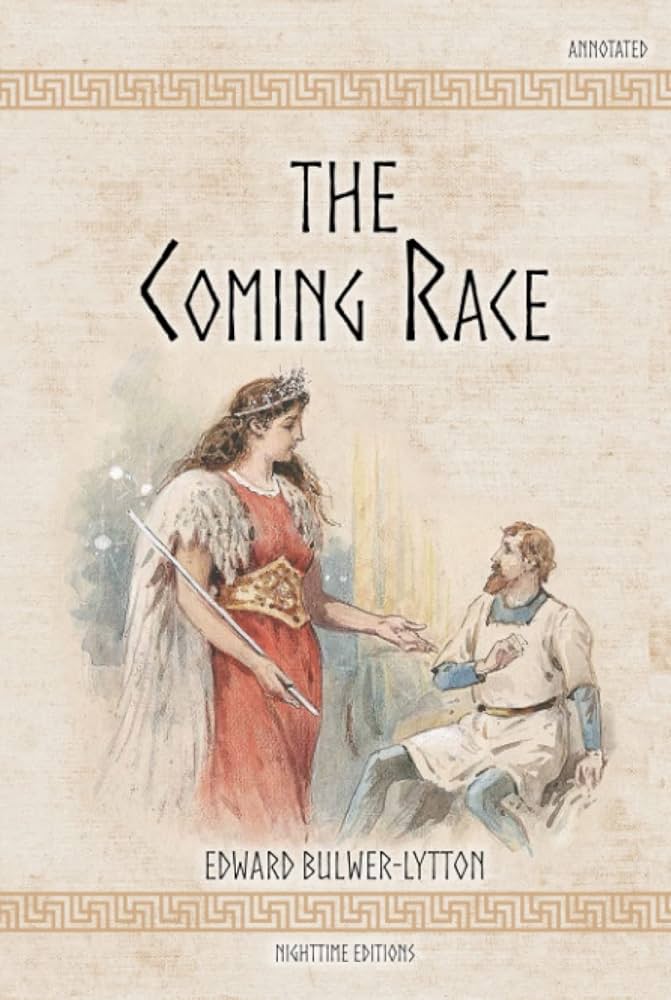Chapter XII — The coming Race
byChapter XII begins with an analysis of the Vril-ya’s language, which stands as a testament to their advanced cultural development and intellectual evolution. Unlike surface languages that often preserve archaic irregularities, theirs has moved toward clarity and simplicity without losing depth. Rooted in a foundation of monosyllabic words, the language evolved through stages of agglutination to sophisticated inflections, balancing brevity with layered meaning. Each word carries exact precision, and even singular letters are imbued with significance. The transformation reflects not just linguistic refinement but also a broader social shift from chaos to structure. Grammar, too, mirrors their collective values—uniform, balanced, and entirely integrated.
The structure of their language prioritizes efficiency and comprehension over ornamental flourish. Words related to governance and emotion are tightly packed with meaning, often requiring no additional explanation. Even in common discourse, there is a philosophical weight to how things are said. The term for leadership, for instance, suggests both duty and limitation, avoiding any connotation of domination. Their political vocabulary is borrowed from foreign roots as a way of discarding older, less egalitarian meanings. Through this, their language actively reshapes perceptions and reinforces new ideals. Language, for the Vril-ya, is not passive—it molds their reality as much as it describes it.
Every term used by the Vril-ya connects directly to experience, often bypassing abstraction in favor of what can be observed or logically reasoned. Concepts of spirituality, science, and personal ethics are linguistically fused, reflecting a worldview where disciplines are not segregated. This has created a clarity of thinking that permeates both private and public life. Their verbs are action-centered yet philosophically driven, with conjugations that reflect intent and consequence. For example, a future-tense verb may vary slightly depending on whether the intended action aligns with community welfare. Such grammatical structures support a moral framework embedded in everyday communication. With this, misunderstandings are rare, and conversations tend to resolve rather than escalate differences.
The history of their linguistic evolution also offers insight into their social journey. Traces of earlier forms reveal contact with other races, now extinct, showing how language adapted and absorbed rather than erased. This inclusive layering gave their vocabulary richness without sacrificing cohesion. Over time, as conflicts faded and societal systems stabilized, the need for metaphor and hyperbole decreased. What remains is a language stripped of confusion, built on reason and collective understanding. Literature within their culture has become sparse—not from disinterest, but because language already captures so much with so little. Written expression is thus used sparingly and with great intention.
Comparing this to our own linguistic structures, the differences are striking. On the surface, human languages may seem richer in literary beauty, yet they often rely on ambiguity and emotional charge. The Vril-ya prefer communication that uplifts through insight, not drama. Their speech lacks aggression and rarely uses imperatives, reflecting a culture that values mutual agreement over command. Even disagreement is framed through syntax that encourages shared exploration rather than opposition. This grammatical gentleness reduces social friction and reinforces their cultural equilibrium. Every element of their language has evolved to sustain balance, not provoke unrest.
The narrator, while immersed in their conversations, often finds himself disoriented by the precision and transparency with which they express ideas. To a visitor raised in a world where communication can be layered with misdirection or nuance, this blunt clarity feels almost otherworldly. But over time, it becomes evident that this linguistic purity arises not from simplicity but from profound intellectual discipline. The Vril-ya consider the act of speaking a civic responsibility, where clarity prevents conflict and nurtures trust. This practice elevates their spoken exchanges into a shared ethical space. Words are never thrown away—they are built with care and delivered with purpose.
This chapter offers a rare look into a civilization where language is not merely a reflection of society, but a mechanism that sustains its very harmony. Through its study, the reader is invited to reflect on how much of modern human discord stems from poorly structured or misused words. If our languages were more attuned to reason, compassion, and clarity, would our societies shift as well? The Vril-ya remind us that language is never neutral; it either nurtures unity or sows division. Their example, though fictional, prompts a rethinking of how language might evolve alongside moral and cultural progress.


